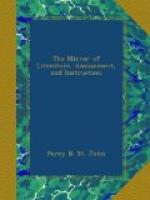their depth considerable in proportion to their diameter;
and that explosions could not be made to pass through
such canals, or through very fine wire sieves, or
wire gauze. The consideration of these facts
led Sir Humphry to adopt a lamp, in which the flame,
by being supplied with only a limited quantity of
air should produce such a quantity of azote and carbonic
acid as to prevent the explosion of the fire-damp,
and which, by the nature of its apertures for giving
admittance and egress to the air, should be rendered
incapable of communicating any explosion to the external
air. These requisites were found to be afforded
by air-tight lanterns, of various constructions, supplied
with air from tubes or canals of small diameter, or
from apertures covered with wire-gauze, placed below
the flame, through which explosions cannot be communicated;
and having a chimney at the upper part, for carrying
off the foul air. Sir Humphry soon afterwards
found that a constant flame might be kept up from
the explosive mixture issuing from the apertures of
a wire-gauze sieve. He introduced a very small
lamp in a cylinder, made of wire-gauze, having six
thousand four hundred apertures in the square inch.
He closed all apertures except those of the gauze,
and introduced the lamp, burning brightly within the
cylinder, into a large jar, containing several quarts
of the most explosive mixture of gas from the distillation
of coal and air; the flame of the wick immediately
disappeared, or rather was lost, for the whole of
the interior of the cylinder became filled with a feeble
but steady flame of a green colour, which burnt for
some minutes, till it had entirely destroyed the explosive
power of the atmosphere. This discovery led to
a most important improvement in the lamp, divested
the fire-damp of all its terrors, and applied its
powers, formerly so destructive, to the production
of a useful light. Some minor improvements, originating
in Sir Humphry’s researches into the nature of
flame, were afterwards effected. Experiments of
the most satisfactory nature were speedily made, and
the invention was soon generally adopted. Some
attempts were made to dispute the honour of this discovery
with its author, but his claims were confirmed by
the investigations of the first philosophers of the
age."[2]—The coal owners of the Tyne and
Wear evinced their sense of the benefits resulting
from this invention, by presenting Sir Humphry with
a handsome service of plate worth nearly two thousand
pounds, at a public dinner at Newcastle, October 11,
1817.
In 1813, Sir Humphry was elected a corresponding member of the Institute of France, and vice-president of the Royal Institution; in 1817, one of the eight associates of the Royal Academy; in 1818 created a baronet, and during the last ten years he has been elected a member of most of the learned bodies of Europe.




